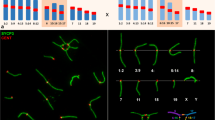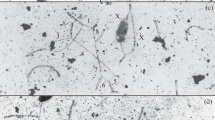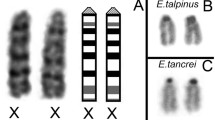Summary
-
1.
Chromosomal rearrangements in Tipula oleracea have been induced by X-raying mature sperms, and have been studied in spermatocytes of F2-males obtained by mating F1-sons of irradiated fathers with normal females. By this method rearrangements including the X-chromosome are not obtainable. More than half of the F2-families contained rearrangements (Table 1, p. 120). Predominant among them are reciprocal translocations between two of the three autosomes, followed in frequency by translocations between all three autosomes. Reciprocal translocations between an autosome and the small Y-chromosome are present in about 5 percent of the F2s. Lines with such Y-autosometranslocation have been chosen for a study of chromosome movements in living spermatocytes, (i) because of the possibility of comparing trivalent, bivalent and univalent behavior within the same cell, (ii) because of the ease with which these rearrangements can be bred, and (iii) because every spermatocyte contains the heterozygous rearrangement.
-
2.
In 52 spermatocytes of the stocks 114, 116, and 216 with reciprocal translocation between Y and an autosome, the movements of 52 trivalents, 104 bivalents, and 42 univalent X-chromosomes were recorded from nuclear membrane breakdown until late anaphase by sketching the minute to minute outlines of the chromosomes and the polar regions of the spindle by means of a camera lucida (Fig. 4). The chromosome movements are represented by diagrams (Fig. 5–19) which together with the original sketches are used as a basis for the evaluation of chromosomal behavior. Whereas definite rules of behavior can be formulated for T. oleacea it must be pointed out that other tipulids show differences in details.
-
3.
During the first maturation division the kinetochores of the two chromatids of each chromosome (whether univalent or member of a bivalent or trivalent) can be oriented in one of two ways: (1) They may be directed to the same pole (i.e. “syntelic”), or (2) they may be oriented to different poles (i.e. “amphitelic”). When kinetochores are syntelic a chromosome lies with its axis parallel to that of the spindle and the following data suggest that from early prometaphase untile late anaphase it is subjected to forces which act in the direction of that pole towards which the kinetochores are oriented. Amphitelic kinetochores cause the principal chromosomal axis to lie perpendicular to that of the spindle and the chromosomes to move into the equatorial plate, the equilibrium position. Chromosomes with amphitelic kinetochores remain in the equator during the anaphasic poleward movement of the chromosomes which have syntelic kinetochores. Only thereafter, and still undivided, they are distributed. During their segregation the chromosome ends precede, the kinetochores are obviously still connected with both poles.
In early and mid prometaphase the chromosomes without exception exhibit syntelic orientation (synorientation). Amphitelic orientation (amphiorientation) commonly takes place in late prometaphase-metaphase. Table 7, p. 175, gives the frequencies of synoriented and amphioriented chromosomes occuring as univalents or as specified members of bivalent and trivalent associations just before the onset of anaphase. There is no detectable difference between autosomes and sex chromosomes in frequency of amphiorientation. Univalents have the highest frequency of amphiorientation; when a chromosome is a member of a bivalent or multivalent, its frequency of amphiorientation depends largely upon positions of cohesion points (chiasmata), and the valency of the association, i.e. upon interactions among the members of the conjoined complex.
-
4.
Syntelic kinetochores are potentially able to reorient. During reorientation the interaction between the chromatid kinetochores of a chromosome and one pole is abolished and the syntelic interaction with a new pole is established within 1 to 3 minutes. After reorientation the chromosomes move with high velocity to that pole to which they newly oriented. The movement stops at a distance from 4 to 1 μ from the pole, provided that it is not interrupted by another reorientation or moderated by the action of the other kinetochores in bivalents and multivalents. Kinetochores may reorient from 0 to as many as 7 times before anaphase, but no reorientation has been observed following the onset of anaphase. On the average, syntelic kinetochores of univalents (see Fig. 23 a, b) remain oriented to one and the same pole for about 20 minutes (=1x); those in bivalents in which the syntelic kinetochores of both members are directed to one pole (monopolar orientation see Fig. 24a) remain so for approximately 10 minutes (i.e. ∼0.5x); corresponding dichiasmatic trivalents (see Fig. 26a) remain unchanged in orientation approximately 2–3 minutes (∼0.1x). On the other hand, the rod of the ring plus rod trivalent (see Fig. 25c, d) remains without change in orientation ∼3x; the terminal members of linear trivalents when oriented to the same pole as the middle member (see upper member in Fig. 25d or lower member in b and e) remain without change ∼6x; all partners in V-shaped trivalents (see Fig. 26c) remain ∼9x; and finally in linear trivalents, the terminal member which is oriented disjunctionolly to the middle member (see upper members in Fig. 26b and e or lower member in d) remains continously oriented to its pole ∼20 x. The ring members in trichiasmatic trivalents (when oriented as in Fig. 25c, d), and the partners of cooriented bivalents (see Fig. 24b), exhibit stable orientation (i.e. ∞x). Thus the average time during which syntelic kinetochores remain continously oriented to one and the same pole depends on whether or not they lie in a univalent, or, if not, upon the positions of cohesion points (chiasmata) and valency of association, i.e. upon the interaction between the members of a pairing complex. Differences in reorientation frequencies between kinetochores of sex chromosomes and autosomes have not been found.
Nearly all of the possible patterns of orientation of bivalents and multivalents have been found, but the frequencies with which specific patterns occured are not those predicted on the basis of chance alone. If the possible modes of orientation for a given meiotic chromosomal association differ in their stability, then the principal modes of orientation will be those which have the highest stability. Thus in metaphase, just before the onset of anaphase, no bivalents occured which had all kinetochores oriented to the same pole; likewise no trivalents occured in which all kinetochores were oriented to the same pole. V-shaped and rod shaped trivalents have about the same stability and occur with approximately equal frequencies.
-
5.
Absolute length of spindle and duration of prometaphase-metaphase may vary from cell to cell within moderate limits. The positions of chromosomes in individual cells may be compared by uniformly and proportionately transforming the raw data so that each case may be regarded as an event within a spindle of constant (viz. mean) length and constant (viz. standardized) prometaphase-metaphase duration. Such corrected positions of univalent X-chromosomes, bivalents, and trivalents are given in three-dimensional plots (Fig. 21, 22). In middle and late prometaphase-metaphase univalents with syntelic kinetochores lie at a distance of 1 to 4μ from that pole to which they are oriented, provided they have not just reoriented and are not moving to the opposite pole. During last third of prometaphase-metaphase an increasing number of univalents change to amphiorientation and enter the equator. A short time before the onset of anaphase two stable positions exist: that of the synoriented univalents located near a pole, and that of the equatorially located amphioriented univalents. The rare univalents which are not in one of these positions are without exception moving to the equator after late amphiorientation or to one pole after late reorientation (Fig. 21). Bivalents that have both members oriented to the same pole go to that pole and stay there until one kinetochore reorients (Fig. 16). Most of the co-oriented bivalents he in the equatorial region. The deviation from this position is most pronounced in early and mid prometaphase, during which some co-oriented bivalents may approach one pole as closely as univalents do; in late prometaphase-metaphase all bivalents lie in the equatorial third of the spindle [i.e. within ± 4μ of the equator (Fig. 21)]. The V-shaped and the rod and ring trivalents occupy positions distinctly nearer to that pole to which two members are oriented (Fig. 22). Again the deviation is more pronounced in early and mid prometaphase than in late prometametaphase, but on the whole it is less than in bivalents. The rod shaped trivalents are less markedly displaced from the equator, but the terminal kinetochore that is oriented to the same pole as the median kinetochore approaches this pole as closely as the kinetochores of other trivalents. Trivalents with one amphitelic kinetochore enter the equator.
-
6.
All prometaphase chromosomes move up and down within the spindle even when their kinetochores do not reorient. Three dimensional plots which show the distribution of velocities in relation to the standardized prometaphase-metaphase duration are given in Fig. 20 for the four different chromosome types (IIIs = stable trivalents that do not reorient; IIIis = instable trivalents that reorient 1 to 7 times; II = bivalents; I = univalent X-chromosomes). The high velocities of many univalents and of some instable trivalents (IIIis) is due to the rapid movements which exhibit syntelic kinetochores after reorientation. But even cooriented bivalents may reach high velocities (up to 2.4μ/min.) during the middle part of prometaphase. Univalent X-chromosomes attain following reorientation the mean velocity of 2.2 ±0.1 μ/min; some reach velocities up to 4 μ/min. Autosomal and Y-kinetochores move with similar velocities after reorientation, but they do not reach as high values as the kinetochores of X-univalents, because one kinetochore of the trivalent opposes the movement. The average velocity during the most rapid part of anaphase movement of bivalent dyads is 0.8±0.1 μ/min. Probably it increases with increased distance from the pole at the beginning of anaphase (Table 5). The kinetochoreto-pole distance is most unequal in the case of disjoining members of trivalents. The mean velocity of those partners which begin their anaphase movement at an average distance of 5.1 μ from the pole is 0.5±0.1 μ/min. They are significantly slower than partners which begin anaphase movements at an average polar distance of 13.7 μ. These exhibits a mean anaphase velocity of 1.2 ±0.2 μ/min. Thus the average velocity of univalents after reorientation is distinctly higher than the anaphase velocity even if corrected for the polar distance that univalents commonly have after reorientation and account is taken of the possibility that the attainable velocity after reorientation decreases in late prometaphase-metaphase.
-
7.
The hypothesis on the spindle mechanism proposed by Dietz (1958) is discussed with regard to the present findings.
Similar content being viewed by others
Literatur
Bauer, H.: Die Chromosomen von Tipula paludosa Meig. in Eibildung und Spermatogenese. Z. Zellforsch. 14, 138–193 (1931).
Böök, J. A.: Equilibrium of trivalents at metaphase. Hereditas (Lund) 31, 499 (1945).
Dietz, R.: Die Spermatocytenteilungen der Tipuliden. II. Mitt. Graphische Analyse der Chromosomenbewegung während der Prometaphase I im Leben. Chromosoma (Berl.) 8, 183–211 (1956).
—: Multiple Gesehlechtsehromosomen bei den Ostracoden, ihre Evolution und ihr Teilungsverhalten. Chromosoma (Berl.) 9, 359–440 (1958).
—: Centrosomenfreie Spindelpole in TipulidenSpermatocyten. Z. Naturforsch. 14b, 749–752 (1959).
Hughes-Schrader, S.: Polarization, kinetochore movements and bivalent structure in the meiotic chromosomes of male mantids. Biol. Bull. 85, 265–300 (1943).
—: The chromosomes of mantids (Orthoptera:Manteidae) in relation to taxonomy. Chromosoma (Berl.) 4, 1–55 (1950).
Inamdar, N. B.: A note on the reorientation within the spindle of the sex-trivalent in a mantid. Biol. Bull. 97, 300–301 (1949).
Inoué, S.: On the physical properties of the mitotic spindle. Ann. N.Y. Acad. Sci. 90, 529–530 (1960).
Izutsu, K.: Phase-contrast cinematographic studies on meiosis in orthopteran spermatocytes. I. Development of the chromosomal spindle fibers and the kinetic behavior of the chromosomes before metaphase. Cytologia (Tokyo) 23, 485–495 (1959).
Michel, K.: Die Kern- und Zellteilung im Zeitrafferfilm. Zeiss-Nachr. 4, 236–251 (1943).
Östergren, G.: Equilibrium of trivalents and the mechanism of chromosome movements. Hereditas (Lund) 31, 498 (1945).
—: Behaviour on the spindle of the actively mobile chromosome ends of rye. Hereditas (Lund) 32, 473–494 (1946).
—: The mechanism of co-orientation in bivalents and multivalents. The theory of orientation by pulling. Hereditas (Lund) 37, 85–156 (1951).
Shimakura, K.: The chromosome movements during the spindle formation as observed in the living spermatocytes of some grasshoppers. Cytologia (Tokyo). Suppl. Internat. Genetics Symp. 1956, 126–128 (1957).
Author information
Authors and Affiliations
Additional information
Frauz Schrader zu seinem 70. Geburtstag in Dankbarkeit gewidmet.
Rights and permissions
About this article
Cite this article
Bauer, H., Dietz, R. & RÖbbelen, C. Die Spermatocytenteilungen der Tipuliden. Chromosoma 12, 116–189 (1961). https://doi.org/10.1007/BF00328918
Received:
Published:
Issue Date:
DOI: https://doi.org/10.1007/BF00328918




